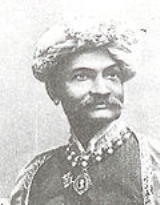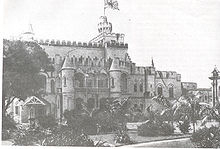
Jatindramohan Tagore
Encyclopedia
See Tagore for disambiguation
Jatindramohan Tagore, , Maharaja Bahadur
, (16 May 1831 – 10 January 1908), was a theatre enthusiast, art-lover, and philanthropist.
, he belonged to the Pathuriaghata
branch of the Tagore family
. On completing his studies at Hindu College, he studied English and Sanskrit at home.His father, Hara Kumar Tagore, was learned in the Hindu scriptures, Sanskrit and English. He had compiled critically admired books and assisted Radhakanta Deb (1783 – 1867) in compiling Sabdakalpadrum.
When Gnanendramohan Tagore
, son of his uncle, Prasanna Coomar Tagore
, converted to Christianity in 1851 and was deprived of inheritance for that reason, he inherited the vast property of his uncle.
 The first house, on the land where Tagore Castle now stands on at 26 Prasanna Kumar Tagore Street in Pathuriaghata, was built by Kali Kumar Tagore. It was a simple three-storey structure. Kali Kumar had given the house to his younger brother Prasanna Coomar. Jatindra Mohan Tagore inherited the property from Prasanna Coomar. In 1895, Jatindra Mohan demolished the old building and started construction of a new building. The plan for the building was prepared by Macintosh Burn and Company from England. It had a 100 feet high centre tower, inspired by the Windsor castle
The first house, on the land where Tagore Castle now stands on at 26 Prasanna Kumar Tagore Street in Pathuriaghata, was built by Kali Kumar Tagore. It was a simple three-storey structure. Kali Kumar had given the house to his younger brother Prasanna Coomar. Jatindra Mohan Tagore inherited the property from Prasanna Coomar. In 1895, Jatindra Mohan demolished the old building and started construction of a new building. The plan for the building was prepared by Macintosh Burn and Company from England. It had a 100 feet high centre tower, inspired by the Windsor castle
, a flag staff, and a clock imported from England. The building had large rooms as in the castles of England. There was an auditorium on the second floor, meant mainly for the staging of plays. In 1954, S.B. House and Land Pvt. Ltd. of Haridas Mundhra
took over the building and has altered most of it to beyond recognition.
, and Dwarkanath Vidyabhusan
’s Somprakash. The first play to be staged at Banga Natyalaya was Kalidas’
Mālavikāgnimitram
in Sanskrit
, in July 1859. A year later, a Bengali translation of the play by Pandit Ramnarayan Tarkaratna was staged.Even prior to the Banga Natyalaya, plays were staged at their house in Pathuriaghata from time to time. He inspired Michael Madhusudan Dutta to compose Tilottamasambhav Kabya and paid the expenses for the printing it.
He was one of the influential art patrons of the day, featuring both as a donor and a purchaser of European paintings at Exhibitions. India's first ever 'Surbahar' concert was featured in his court.
The famous 'Nulo Gopal' who was also one of the first guru's of sarode maestro Ustad Allauddin Khan
resided in his court.
He was secretary and president of British Indian Association
, member of the Viceroy’s council, Education Commission, Calcutta University
, and Indian Museum
. He had a museum in Tagore Castle.
He wrote extensively in English, Bengali and Sanskrit.
is named in Jatindra Mohan Tagore's honour.
Jatindramohan Tagore, , Maharaja Bahadur
Maharaja
Mahārāja is a Sanskrit title for a "great king" or "high king". The female equivalent title Maharani denotes either the wife of a Maharaja or, in states where that was customary, a woman ruling in her own right. The widow of a Maharaja is known as a Rajamata...
, (16 May 1831 – 10 January 1908), was a theatre enthusiast, art-lover, and philanthropist.
Early life
The son of Hara Kumar Tagore (1798 – 1858) and grandson of Gopi Mohan Tagore, one of the founders of Hindu CollegePresidency College, Kolkata
Presidency University, Kolkata, formerly Hindu College and Presidency College, is a unitary, state aided university, located in Kolkata, West Bengal. and one of the premier institutes of learning of liberal arts and sciences in India. In 2002 it was ranked number one by the weekly news magazine...
, he belonged to the Pathuriaghata
Pathuriaghata
Pathuriaghata is a neighbourhood in north Kolkata, earlier known as Calcutta, in the Indian state of West Bengal. It is one of the oldest residential areas in what was Sutanuti. Once the abode of the Bengali rich, the neighbourhood and its surrounding areas are now dominated by Marwaris...
branch of the Tagore family
Tagore family
The Tagore family, with over three hundred years of history, has been one of the leading families of Kolkata, and is regarded as a key influence during the Bengal Renaissance...
. On completing his studies at Hindu College, he studied English and Sanskrit at home.His father, Hara Kumar Tagore, was learned in the Hindu scriptures, Sanskrit and English. He had compiled critically admired books and assisted Radhakanta Deb (1783 – 1867) in compiling Sabdakalpadrum.
When Gnanendramohan Tagore
Gnanendramohan Tagore
See Tagore for disambiguationGnanendramohan Tagore was the first Asian to be called to the bar in England, in 1862.- Early life :...
, son of his uncle, Prasanna Coomar Tagore
Prasanna Coomar Tagore
See Tagore for disambiguationPrasanna Coomar Tagore was son of Gopi Mohan Tagore, one of the founders of Hindu College. He belonged to the Pathuriaghata branch of the Tagore family and was one of the leaders of the conservative branch of Hindu society...
, converted to Christianity in 1851 and was deprived of inheritance for that reason, he inherited the vast property of his uncle.
Tagore Castle

Windsor Castle
Windsor Castle is a medieval castle and royal residence in Windsor in the English county of Berkshire, notable for its long association with the British royal family and its architecture. The original castle was built after the Norman invasion by William the Conqueror. Since the time of Henry I it...
, a flag staff, and a clock imported from England. The building had large rooms as in the castles of England. There was an auditorium on the second floor, meant mainly for the staging of plays. In 1954, S.B. House and Land Pvt. Ltd. of Haridas Mundhra
Haridas Mundhra
Haridas Mundhra was a Calcutta-based industrialist and stock speculator who was found guilty and imprisoned in the first big financial scandal of free India in the 1950s. The Mundhra scandal exposed the rifts between the then Prime Minister Jawaharlal Nehru and his son-in-law Feroze Gandhi, and...
took over the building and has altered most of it to beyond recognition.
Banga Natyalaya
Jatindra Mohan Tagore and his brother Shourendra Mohan Tagore, both theatre enthusiasts, started the Banga Natylalay in Pathuriaghata. Among the plays produced by Banga Natyalay during its fourteen-year life were a Sanskrit and eight Bengali plays. These were reviewed by contemporary newspapers such as Hindu Patriot which flourished under Harish Chandra MukherjeeHarish Chandra Mukherjee
Harish Chandra Mukherjee , was an Indian journalist and patriot, who fought tooth and nail for the indigo cultivators and forced the government to bring about changes.-Early life:...
, and Dwarkanath Vidyabhusan
Dwarkanath Vidyabhusan
Dwarkanath Vidyabhusan was an Indian scholar, editor and publisher of the trend-setting weekly Bengali newspaper Somprakash.-Father:His father, Harachandra Bhattacharya was a scholar...
’s Somprakash. The first play to be staged at Banga Natyalaya was Kalidas’
Kalidasa
Kālidāsa was a renowned Classical Sanskrit writer, widely regarded as the greatest poet and dramatist in the Sanskrit language...
Mālavikāgnimitram
Malavikagnimitram
Mālavikāgnimitram is a Sanskrit play by Kālidāsa. It is his first play.The play tells the story of the love of King Agnimitra, the Shunga king of Vidisha , for the beautiful hand-maiden of his chief queen. He falls in love with the picture of an exiled servant girl named Mālavikā...
in Sanskrit
Sanskrit
Sanskrit , is a historical Indo-Aryan language and the primary liturgical language of Hinduism, Jainism and Buddhism.Buddhism: besides Pali, see Buddhist Hybrid Sanskrit Today, it is listed as one of the 22 scheduled languages of India and is an official language of the state of Uttarakhand...
, in July 1859. A year later, a Bengali translation of the play by Pandit Ramnarayan Tarkaratna was staged.Even prior to the Banga Natyalaya, plays were staged at their house in Pathuriaghata from time to time. He inspired Michael Madhusudan Dutta to compose Tilottamasambhav Kabya and paid the expenses for the printing it.
Music and Painting
Jatindramohan was drawn towards music. Under his patronage Kshetramohan Goswami was the first in India to experiment with orchestra or group music. It was a path-breaking achievement in a country with the tradition of solo music and was an attempt at fusion of western music with Indian traditions.He was one of the influential art patrons of the day, featuring both as a donor and a purchaser of European paintings at Exhibitions. India's first ever 'Surbahar' concert was featured in his court.
The famous 'Nulo Gopal' who was also one of the first guru's of sarode maestro Ustad Allauddin Khan
Allauddin Khan
Allauddin Khan , was a Bengali sarodiya and multi-instrumentalist, composer and one of the most renowned music teachers of the 20th Century in Indian classical music.In 1935, he toured Europe, along with Uday Shankar's ballet troupe, and later also worked at his...
resided in his court.
Other activities
A man of varied tastes he donated extensively for public causes. He spent unhesitatingly for the rehabilitation of widows.He was secretary and president of British Indian Association
British Indian Association
The British Indian Association was established on 31 October 1851. Its formation was a major event of 19th century India. Its establishment meant Indians had come together and could no longer be ignored...
, member of the Viceroy’s council, Education Commission, Calcutta University
University of Calcutta
The University of Calcutta is a public university located in the city of Kolkata , India, founded on 24 January 1857...
, and Indian Museum
Indian Museum
The Indian Museum is the largest museum in India and has rare collections of antiques, armour and ornaments, fossils, skeletons, mummies, and Mughal paintings...
. He had a museum in Tagore Castle.
He wrote extensively in English, Bengali and Sanskrit.
Legacy
Jatindra Mohan Avenue, the northern extension of Central AvenueChittaranjan Avenue
Chittaranjan Avenue, more commonly C.R. Avenue, is the previous Central Avenue, a principal north-south thoroughfare in north and central Kolkata.-Stretch:...
is named in Jatindra Mohan Tagore's honour.

